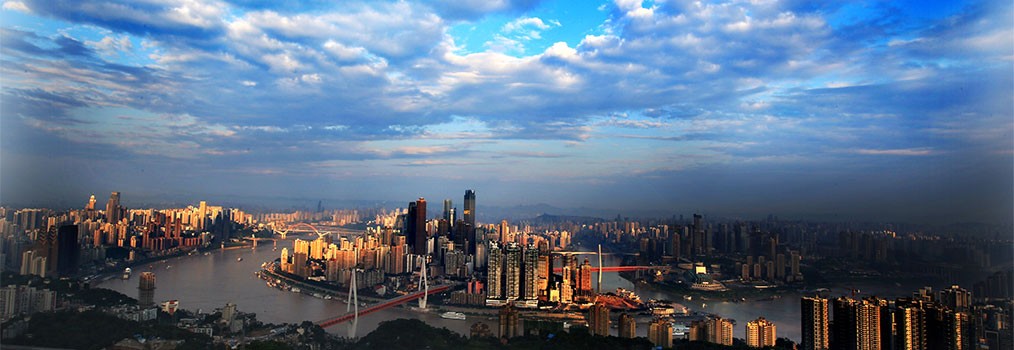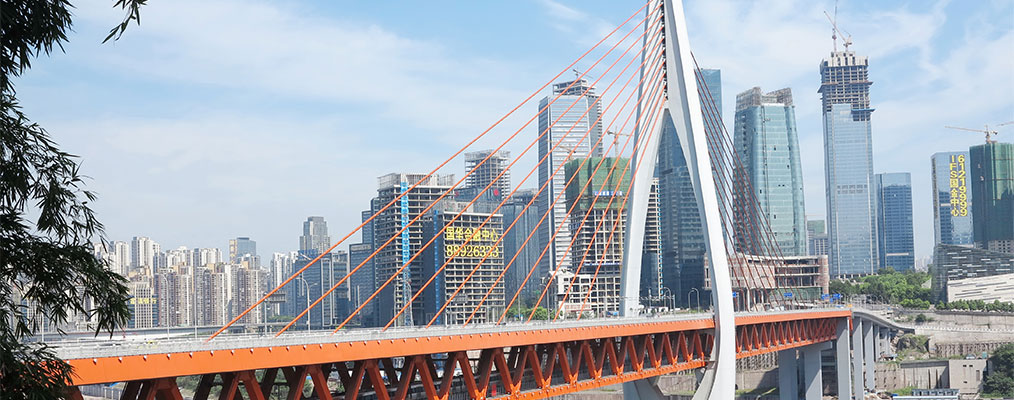
Chongqing, the city located in the southwest area of China, called Ba and Yu in short, is also known as Ba-Yu, Yudu City, Mountain City, Bridge City and Fog City by the people. Chongqing is more than a municipality directly under the Central Government of the People's Republic of China, it’s also a national center city, a mega-city, a world hot spring capital, the economic center, financial center, and innovation center in the upper reaches of the Yangtze River. These years, the State Council has positioned Chongqing as an international metropolis with center of politics, culture, technology, education and art. It is an integrated transport hub of water, land and air in the midwest area of China.
Chongqing is a famous historical and cultural city in China. Over the history of more than 3000 years, it has created its Ba-Yu culture brightly and particularly. In the sixteenth year of Song Chun Xi's reign (Emperor Zhao Shen, also known as Emperor XiaoZong’s third and last reign title), Zhao Dun (Zhao Shen’s son, also known as Emperor GuangZong) first accepted the investiture as the Prince of Gong (the prince be responsible for the Gongzhou City), and few years later he ascended the throne, then claimed himself as ShuangChongXiQing (which means double happy events in Chinese). At the same time, he promoted the rank of Gongzhou City and named it as Chongqing (short for the ShuangChongXiQing), that is why we call the city Chongqing today.
Chongqing is known as the Chinese Hot-pot Capital, the World Hot Spring Capital and the famous exhibition city of China. It has become the capital of the land for three times and has been established to a major city for four times. During World War II, it was the wartime capital of the Republic of China and the Far East Command Center of the World Anti-Fascist War. In 1997, it was restored to a municipality.
Historically, Chongqing has been a major trading inland port, transporting goods from the southwestern provinces to eastern China. During the Sino-Japanese War (1937-1945), Chongqing was transformed into a city with heavy industry, especially the military industry which continued to thrive for decades after 1949. Since 1980s, many of these military industry enterprises have undergone reforms and turned from producing military goods to mostly civilian products for survival and growth. Chongqing has witnessed great changes after it became the municipality directly under the central government in China in 1997. During the 21st century, the economy of Chongqing has developed rapidly.
According to the data shown in Chongqing government's economic work report from last year, Chongqing maintained steady growth in its economy, having accelerated transformation to its growth model, promoted structural adjustments and improved the quality and performance of economic growth.
In order to implement the Western Development strategy, Chinese government set up an economic zone called the West Triangle Economic Zone comprising Chengdu, Chongqing and Xi'an, which contributes nearly 40% of Western China's GDP every year. In addition, Chongqing is one of China's five National Central Cities. Besides, some large central business districts are being constructed in the centre of the city of Chongqing, such as Jiangbeizui CBD and New North Zone. These new economy zones will spur the development of the Chongqing economy and bring more opportunities.

Chongqing stands ahead of most cities in China with its abundant tourism resources. In the year of 2012, it was rated “One of top 10 tourist attractions in the world” by Frommer’s, a famous tour guide of the U.S.. At present, Chongqing enjoys some 214 tourist attractions of A level among which there are 8 AAAAA national grade scenic spots, 75 AAAA national grade scenic spots, 80 AAA national grade scenic spots. In addition, Chongqing also enjoys 2 world cultural heritage sites, namely Wulong Karst tourist attraction and Jinfo Mountain, and a natural and cultural heritage, namely Dazu Rock Carvings. Chongqing is endowed with numerous famous scenic spots and tourist attractions, such as the Three Gorges, Fengjie Tiankeng, Hechuan Fish Town, the White Crane Ridge of Fuling and so on. They all are globally well-known with prestige. In addition, Chongqing also features a large number of amusing and entertaining shopping malls, such as the foreigner street with foods all over the world and the buildings of varied styles. Chongqing has a trading port on the bank of the Jialing River that thrived during the period of Ming and Qing dynasty. Today, the trading port has become an ancient town known as Ciqikou, the symbol and miniature of ancient Chongqing or Jiangzhou. In the end, Chongqing features Jiefangbei pedestrian street offering luxuries, local featured foods and impressive shopping experience.
The night view of Chongqing was once listed as one of the three best urban night views in the world, known as the Million-dollar Night View. The best place for people to overlook this beautiful scene is Yikeshu Sightseeing Stand, Nanshan Mountain. The sightseeing stand has a high terrain and a wide field of vision. From Yikeshu, you can enjoy a city of stars over Yuzhong Peninsula. What’s more? It is also a wonderland for photographers. Every evening, you can see both diamonds drifting in the sky and people crowding on the platform, which means photography fans have to take their machines and come here early to occupy the best position.

With rapid economic growth and constantly improved infrastructure, the traffic construction in Chongqing witnessed breakthroughs by building 16 large bridges over the Yangtze River and Jialing River. A large number of provincial and county-level highways have been completed and put into operation. The construction of railway transportation has been strengthened. For example, Chongqing-Beijing and Chongqing-Chengdu high-speed railways along with others have been put into operation; Chongqing Municipal People’s Government attached importance to the construction of the facilities at airport and improving passenger reception quality. In 2015 alone, Chongqing Jiangbei Airport witnessed a handling capacity of 32.4 million persons. In addition, Chongqing leads in information development in western China and is a modern communication network city with a large capacity and high rate predominated by optical cable. Urban development is consistently strengthened. The redevelopment of old and dangerous houses, corrections of unfinished buildings and the development of public service facilities and cultural facilities have been completed. The relaxing natural landscapes are in dialogue with the elegant modern architectures, allowing Chongqing to step into a new century in a brand new look.

Chongqing is seated at the conjunction of the Yangtze River and the Jialing River, surrounded by mountains and two rivers. The mountain city Chongqing, with a long history of over 3,000 years, has rich tourism resources. The city has splendid natural views of mountains, rivers, forests, streams, waterfalls, gorges and caves on the one hand, and rich cultural views on the other, namely, Bayu culture, ethnic culture, immigration culture, Three Gorges culture, wartime capital culture and urban culture.
Hotpot and night view are Chongqing's two features. The spicy and delicious hot pot represents not only the Chongqing cuisine, but also the vigorous and open personalities of the mountain city and its people. The night view here is the most well-known scenery in Chongqing. No matter you are standing at the viewing platform on Nanshan Mountain, walking by the riverside, or taking the Yangtze River cable-way to look down at the city, you can always appreciate the gorgeous night view of Chongqing, the “Little Hong Kong” and get a full view of the two rivers.
The enchanting sceneries of Chongqing lie in the mountains and forests and exist at streets and alleys, waiting for you to explore.